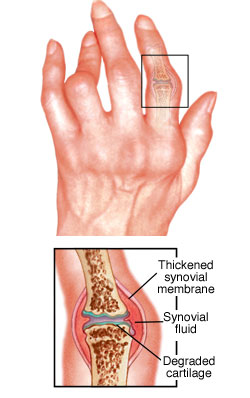
Rheumatoid arthritis is type of inflammatory disease which principally affects the small joints of the hands and feet along with other organs of the body. Rheumatoid arthritis is a chronic disease which without adequate treatment may lead to loss of function and mobility.
In contrast to another common arthritis the osteoarthritis in which there is wear and tear damage of the cartilage lining the adjacent bony surfaces in a joint; in rheumatoid arthritis the lining of the joint, the synovial membrane is affected. As the synovial membrane is affected painful swellings of the affected joints may occur leading to stiffness and restricted joint movement. In advanced cases bony erosion along with joint deformity may occur. Other than joints rheumatoid arthritis may affect other systems of the body like inflammatory damage to the protective linings of the lung (the pleura), white part of the eye (the sclera) etc.
In autoimmune disease the immune system of the body wrongly attacks the body’s own cells (“self” cells) instead of the invading foreign cells leading to damage of different organs. Rheumatoid arthritis is considered to be a systemic autoimmune disease.
In the US alone about 0.6% of the total population suffers from rheumatoid arthritis. This condition is more common in females in comparison to males and more commonly people in the middle age are affected by rheumatoid arthritis (although people of any age group may suffer from rheumatoid arthritis).
Available treatment options are either non pharmacological or pharmacological. Non pharmacological treatment measures include physical therapy, occupational therapy, nutritional therapy etc although these non pharmacological measures do not actually arrest the progression of the disease. Pharmacological measures include administration of pain killers, anti inflammatory drugs like corticosteroids, disease modifying anti rheumatic drugs (DMARDs) etc.
Symptoms
Rheumatoid arthritis affects different systems of the body although small joints are most commonly affected. In about 15 to 25% of the total affected people other organs besides the joints are also affected. Other than the symptoms due to the disease sometimes symptoms may arise as a side-effect of the drugs administered for treatment.
Different common symptoms are
1. Joint involvement: this is characterized by inflammation of the synovial membranes of different joints leading to swollen and painful stiff joints with restricted movement. Rheumatoid arthritis involves more than one joint at a time (polyarthritis) usually in a symmetric fashion. Commonly involved joints are small joints like joints of the hands, feet, back of the neck (cervical joints) etc, although larger joints like knee and shoulder joints may also be affected. Chronic inflammation of the synovial membrane leads to typical deformities of the joints namely ulnar deviation, boutonnnniere deformity, swan neck deformity, z thumb, hammer toe deformity etc. in severe cases joint destruction (arthritis mutilans) may also occur. In most of the cases the affected joints show symptoms (pain, swelling, tenderness, restricted mobility) typically in the early morning lasting for about an hour. Gentle movement of the joints typically helps to relieve pain and stiffness during the early days of the disease; this feature helps to distinguish rheumatoid arthritis from other non inflammatory joint disorders namely osteoarthritis.
Other than joint involvement longstanding rheumatoid arthritis may lead to weakening of bones, repeated episodes of fracture following minimal trauma etc.
2. Skin involvement: the most common skin lesion associated with rheumatoid arthritis is rheumatoid nodules. These nodules are few mm to few cm in size and characteristically located on different bony prominences of eth body namely the olecranon process (the bony prominence located just behind the elbow), calcaneal tuborosity (the heel bone) etc. Inflammatory changes in the vessels may also occur in the blood vessels of the skin (vasculitis)
3. Lung involvement: shortness of breath which gradually becomes worse with time is a common lung symptom experienced by patients of rheumatoid arthritis. The underlying cause is inflammation and subsequent scarring of the lung tissue.
4. Cardiovascular system involvement: the incidence of several cardiovascular health conditions like atherosclerosis (accumulation of fatty substances along the inner lining of the blood vessels), heart attack (myocardial infarction) etc may increase in patients of rheumatoid arthritis.
5. Other symptoms include inflammatory changes in the eyes leading to visual problems with painful red eyes due to scleritis, episcleritis, keratitis etc, anemia (fall in hemoglobin level) leading to fatigue, weakness, palpitation, nerve involvements like peripheral neuropathy, carpal tunnel syndrome leading to tingling, numbness may also occur etc.





